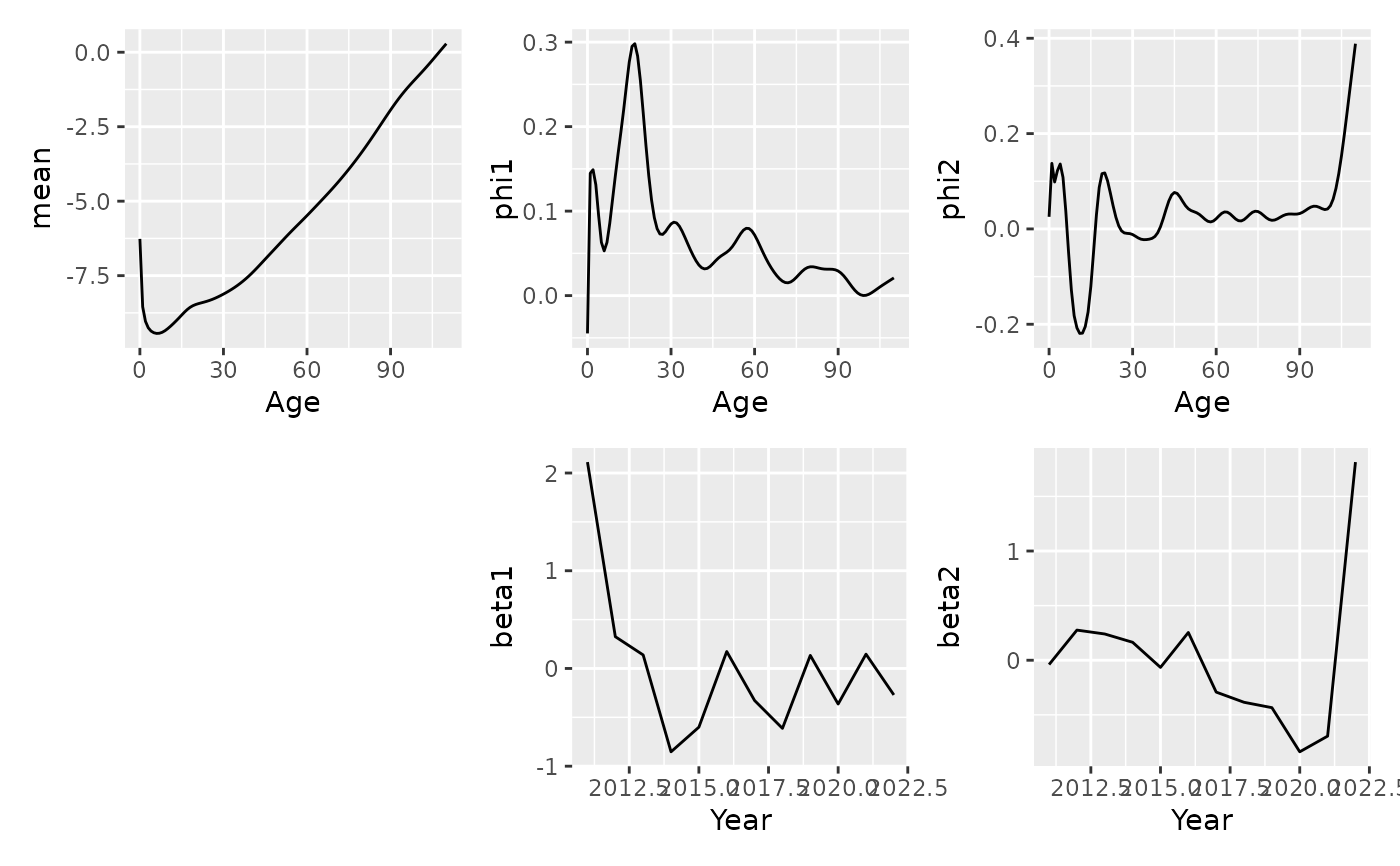Functional data model of mortality or fertility rates as a function of age.
FDM() returns a functional data model applied to the formula's response
variable as a function of age.
Usage
FDM(formula, order = 6, ts_model_fn = fable::ARIMA, coherent = FALSE, ...)Arguments
- formula
Model specification.
- order
Number of principal components to fit.
- ts_model_fn
Univariate time series modelling function for the coefficients. Any model that works with the fable package is ok. Default is
fable::ARIMA().- coherent
If TRUE, fitted models are stationary, other than for the case of a key variable taking the value
geometric_meanormean. This is designed to work with vitals produced usingmake_pr()andmake_sd. Default is FALSE. It only works whents_model_fnisARIMA().- ...
Not used.
References
Hyndman, R. J., and Ullah, S. (2007) Robust forecasting of mortality and fertility rates: a functional data approach. Computational Statistics & Data Analysis, 5, 4942-4956. https://robjhyndman.com/publications/funcfor/
Hyndman, R. J., Booth, H., & Yasmeen, F. (2013). Coherent mortality forecasting: the product-ratio method with functional time series models. Demography, 50(1), 261-283. https://robjhyndman.com/publications/coherentfdm/
Examples
hu <- norway_mortality |>
dplyr::filter(Sex == "Female", Year > 2010) |>
smooth_mortality(Mortality) |>
model(hyndman_ullah = FDM(log(.smooth)))
report(hu)
#> Series: .smooth
#> Model: FDM
#> Transformation: log(.smooth)
#>
#> Basis functions
#> # A tibble: 111 × 8
#> Age mean phi1 phi2 phi3 phi4 phi5 phi6
#> <dbl> <dbl> <dbl> <dbl> <dbl> <dbl> <dbl> <dbl>
#> 1 0 -6.27 -0.0470 0.153 0.107 0.220 0.00196 -0.299
#> 2 1 -8.51 0.167 0.107 0.295 0.00735 -0.410 -0.269
#> 3 2 -9.00 0.170 0.0341 0.295 -0.00474 -0.314 -0.195
#> 4 3 -9.22 0.155 -0.0284 0.298 -0.0733 -0.121 -0.0204
#> 5 4 -9.33 0.119 -0.0878 0.298 -0.125 0.0290 0.103
#> # ℹ 106 more rows
#>
#> Coefficients
#> # A tsibble: 13 x 8 [1Y]
#> Year mean beta1 beta2 beta3 beta4 beta5 beta6
#> <int> <dbl> <dbl> <dbl> <dbl> <dbl> <dbl> <dbl>
#> 1 2011 1 2.06 0.297 -0.562 0.0844 0.164 0.119
#> 2 2012 1 0.356 0.135 0.943 0.543 0.314 -0.134
#> 3 2013 1 0.126 0.662 0.334 0.437 -0.0629 0.0955
#> 4 2014 1 -0.892 0.729 -0.246 0.175 0.258 0.0968
#> 5 2015 1 -0.652 0.678 -0.418 0.128 -0.410 0.0857
#> # ℹ 8 more rows
#>
#> Time series models
#> beta1 : ARIMA(0,0,0)
#> beta2 : ARIMA(1,0,0)
#> beta3 : ARIMA(0,0,0)
#> beta4 : ARIMA(0,0,0)
#> beta5 : ARIMA(0,0,0)
#> beta6 : ARIMA(0,0,0)
#>
#> Variance explained
#> 34.57 + 23.46 + 18.78 + 13.54 + 5.59 + 1.5 = 97.45%
autoplot(hu)
